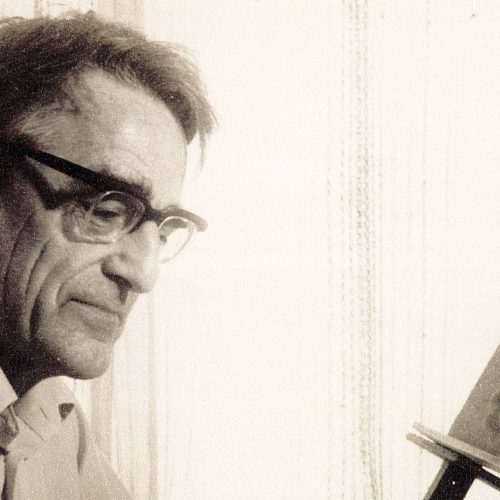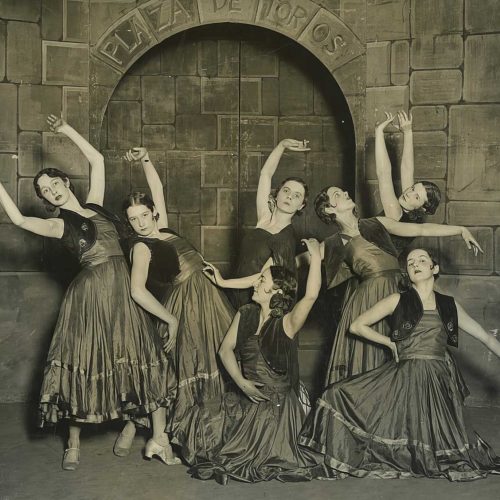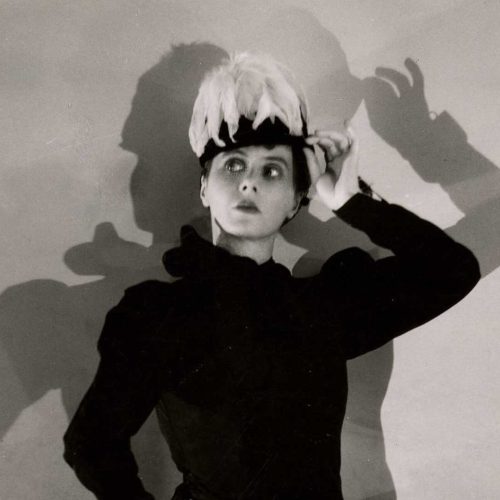James MacMillan
James MacMillan is one of the world’s most prolific and widely respected composers. To date, two of his works have been used in ballets, both choreographed by Christopher Wheeldon. The first of these is his Tryst, an early work, which helped to establish MacMillan as a composer. James speaks here of the way he and Wheeldon approached Tryst more than a decade after its composition, and of the relationship between the choreography and his music. He then talks about Shambards, the name of a ballet Wheeldon set to MacMillan’s second piano concerto, and also about some of the controversy which arose from the piece, both in New York, and in his native Scotland.
First published: June 24, 2025
Biography
James MacMillan was born in 1959. Since the premiere of his The Confession of Isobel Gowdie in 1990, he has established himself as one of the world’s most prolific and successful composers, as well as an orchestral and choral conductor on the international stage. His music is filled with influences from his Scottish heritage, from his social conscience, from Celtic folk music, and above all from his Catholic faith. His works include four symphonies, a number of concerti (including three for piano), a number of cantatas and two Passions (St. John and St. Luke). Two of his compositions Tryst and Shambards (from his second piano concerto) have been choreographed in ballets by Christopher Wheeldon for the Royal Ballet in 2002 and New York City Ballet in 2004, respectively. James MacMillan was appointed CBE in 2004 and knighted in 2015.
Transcript
In conversation with Stephen Johnson
James Macmillan: The title, Tryst, comes from a song which is a song of mine, but a setting of a poem by William Soutar, the Scottish writer. So it’s actually my music, but it was written in such a way that it was meant to sound like, you know, one of these very old ballads that would have been sung in Scotland in the 17th or 18th century. And the melody that I used for that became the beginning or the basis of many other pieces, including this piece, Tryst, for orchestra.
Stephen Johnson: Tryst was, I think, your breakthrough orchestral piece, wasn’t it? It was the first… one of the first works with which you came to wider attention.
James Macmillan: Yes. I wrote it in the late 1980s, the Scottish Chamber Orchestra gave its first performance at the St Magnus Festival in 1989, I think. So it was a chamber orchestral piece. No trombones, not heavy percussion or anything, but it was the first time a piece of mine, a big piece of mine, sort of travelled. The word ‘tryst’ is usually associated with a meeting place for lovers, sometimes a secret place, in fact there’s a kind of secret, nocturnal aspect to the William Soutar poem, and for the orchestral piece that grew out of this, the word is still appropriate, because there is a kind of meeting place in the music of various musical strands that I love. Scottish traditional music, the music of [Igor] Stravinsky, big band music, jazz, even, [Dmitri] Shostakovich. The kind of things that I was passionate about at the time all come together in a kind of melange in this piece.
Stephen Johnson: So, we turn into the new millennium, more than twenty years later this piece is still in the repertory and then you were approached by the Royal Ballet about turning it into a ballet.
James Macmillan: That’s right. Christopher Wheeldon, like many choreographers, are always on the lookout for new music that they might use for their own work, to choreograph, and he had been listening to some of mine, and I think this piece struck him as eminently suitable because it has… it’s full of dance rhythms. In fact, the only slow music in the orchestral piece is a slow, central core, and it’s the section that is most influenced by the folk song, as it were. The rest of it, the outer movements, the beginning and the end, are all very fast, rhythmic, arrhythmic, dance-like movements, so I could see in retrospect, now, why Christopher would warm to it and saw potential in it.
Stephen Johnson: So how did they go about the process… how involved were you in the process of turning Tryst into a ballet?
James Macmillan: Well, they asked me to conduct it for the performances at the Royal Ballet, so I suppose I was very much involved, very hands on involved in the rehearsal processes. I didn’t get too involved with the period in which Christopher was putting together his ideas and planning the choreography, but I was able to sit through the rehearsals with piano… they were dancing to a piano reduction, and I was able to oversee tempi and so on. Luckily, it worked out, because sometimes it doesn’t work out, but luckily I had pointed him to one of the recordings that I especially liked, with the idea that when I conducted it, it would probably be a bit like that, as far as speeds are concerned. So he was able to get a very clear idea of what I would likely do with the speeds, because the problem is if music becomes slower, especially slower in rehearsal and performance, the dancers, who may have been rehearsing to the pianist, or even the CD, will have got it into their bones in a very different way, so we had to be careful about that.
Stephen Johnson: But it’s interesting, there is this tension. You can’t just follow your inner directives as you would normally aspire to as a conductor of your own work.
James Macmillan: I think that’s right. The musicians and in this case the composer had to be the servant of the choreographer. Luckily it didn’t mean I had to change a note or anything, it was just the odd little practical consideration that one had to remember to always be aware of what was happening on stage so that things could connect and coordinate well.
Stephen Johnson: What about the whole experience of seeing a visual analogy to a sound piece? A piece that is conceived in terms of sound? Did you think sometimes that there were things that Christopher did that were interesting in the way they reflected events or colours or textures in the music? More general…
James Macmillan: There’s a couple of things. There were some very intriguing, and I think very beautiful and witty hand movements in the first section. My music is very busy, it’s very complex, but it’s also… there are an awful lot of things happening, so these very detailed, planned movements of the hand… hands, that the dancers were instructed to take on board, seemed to be, again, a natural amplification and consequence of the music. The other thing, of course, is that there were other artists involved. It wasn’t just Christopher and the dancers, there was a design set, and the design had an amazing counterpoint, too, to the music. There’s one section after, or just coming out of the slow section, where the orchestra expands from a single pitch out into a cluster, so it grows into this really tense, shuddery tremolando, and strings and timpani, and then it dissolves back again to the single note, and at that moment there was a… it was almost as if the sun or the moon had moved… was moving very, very quickly over the back of the stage, and obviously that had been taken into account by both the choreographer and designer, but it was a design moment which seemed very, very beautiful, and in keeping with what was there in the music, and the eyes of the dancers followed this celestial body as it went from one side of the stage to the other. I found that very touching.
Stephen Johnson: Was this your first experience of being, really, behind the scenes in the ballet, or did you… were you a balletomane beforehand?
James Macmillan: No, I’d had no real contact with ballet until then, but in the wake of this, Christopher came back with another idea for another piece that he would choreograph again from scratch, but I would write the music for it. In fact, what he wanted to do was… he wanted to use an existing piece of mine called Cumnock Fair, which originally existed just as a ten, twelve minute movement, for either piano and strings, or sometimes it can be done with piano… well, string quintet and piano. So we decided we would use that as the first movement of the new piece, and I would write two new movements, and it became my second piano concerto, Cumnock Fair being the first one… first movement, then Shambards, was the second movement, the slow movement, and then a third movement called Shamnation, and there’s lots of complicated, slightly fraught reasons for why those titles were chosen that, kind of, gets me into trouble in Scotland, however I wrote these two extra movements, gave Christopher the music, and he choreographed a three movement piece, as it were, probably about half an hour in length, for New York City Ballet, and he took the title of the middle movement as the overall generic title for the whole thing. Shambards. It’s a sort of tongue in cheek parody of Scottish-ness. There are allusions to Lucia di Lammermoor, even at one point [Gaetano] Donizetti, via [Walter] Scott, of course, and lots of Robert Burns, and folk music and traditional music.
Stephen Johnson: And Shamnation? Controversial concept.
James Macmillan: Yes. Well, exactly. Just the very sound of those words can raise hackles in Scotland. Yes, the title, ‘Shambard’ is a fusion of two words that are used in Edwin Muir’s poem where he talks about ‘sham bards’ for a ‘sham nation’. The sham bards in his deduction are, of course, Burns and Scott, but it’s a kind of condemnation of the inauthenticity of the cults that grow around certain aspects of Scottish… literary life and Scottish cultural life, that he was quite accusatory of. But as a kind of provocation, in a way, and using the two names, and it’s just a little bit provocative. There were even letters in the Glasgow Herald complaining about the titles, not that the piece had ever been performed as a ballet, so they didn’t see what Christopher did with it, it was something very beautiful, but there was a real violence at the heart of Shambards, his choreography, which I think shocked some of the balletomanes in New York. I didn’t see what the issue was, but it was a different aspect and different approach to Tryst.
Stephen Johnson: Do you know what it was that shocked them?
James Macmillan: It was something about the lead dancer pulling the lead female dancer across the stage. It seemed to be… the word misogynistic was used in some of the reviews. I just couldn’t get it, myself. I’ve seen these things in drama and theatre all the time, and in opera, of course. Maybe there was some convention being undermined in what Christopher was doing on the piece, I didn’t quite get it, but it certainly seemed to raise eyebrows in New York.
Stephen Johnson: Again, how did you feel when you saw your music in Shambards choreographed, staged…
James Macmillan: I was delighted with it. It was a wonderful experience. Again, New York City Ballet got me over to conduct it. I did the first run of performances in New York. It was a curious feeling, in a way, because it was a piano concerto, but our pianist, our soloist, was in the pit, of course, along with the rest of the musicians, and to be honest, hardly acknowledged as a soloist, but he was their regular player, so he was used to it. So it was strange in that way, because it’s a fiendishly and very important piano part. It’s a real concerto idea where the soloist is pitted against the group, the ensemble, the assembly, as it were. So it was interesting from that point of view. Eventually the piece did find its way into the concert hall and the soloists are given pride of place. I felt a little sad for the player, looking back, that he wasn’t acknowledged in the usual way, but that’s ballet.
The transcript of this podcast may have been lightly edited for ease of reading.




